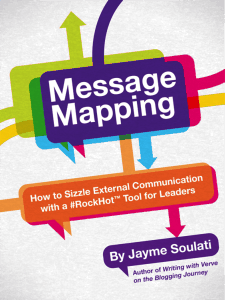 What is a message map?
What is a message map?
In Jayme Soulati’s (that’s me) new e-book, Message Mapping: How to Sizzle External Communication with a #RockHot Tool for Leaders, I explain the concept of message mapping and why any company small, solo, mid-sized, or large needs this tool.
The e-book, available only at https://MessageMapping.co, also provides a step-by-step example of a message mapping exercise for a fictitious company. Readers are walked through the exercise to create messages that form the foundation of external communication.
Message maps are born in the media relations field within the profession of public relations. I have been doing message maps for 20 years for a broad brush of companies in all shapes and sizes with expertise from Chicago’s agencies.
Those people who work in the crisis communications field also use message maps to ensure that spokespeople are on message and less apt to stray from the approved messaging platform.
In this era of social media, companies may be in the spotlight of journalists less. This doesn’t mean preparation is not required or necessary; to the contrary. Spokespeople need to be ultra prepared today to ensure they can answer questions from many different channels. Having a message map is the first step in ensuring that comfort.
My book teaches marketers, public relations executives, business owners, and more how to work with a facilitator, the steps in the process, how messages are developed, and finally the step-by-step process to making a message map come alive.
Buy my e-book now, right here.
It’s a tool every company needs for copywriting, social media, media relations, website development, internal communications, and more.
Big Thanks
A team was instrumental in bringing this book to market. Without the help and expertise of Scott Quillin of New England Multimedia; Glen Moyes of Glen Moyes Design; and, Jenn Whinnem, this book would still be a seedling. My heartfelt thanks.
Two Books
Within six months, I have authored two books.
The first, “Writing with Verve on the Blogging Journey,” available as an e-book or softcover via Amazon or Greyden Press, is a three-year collection of blog posts about blogging. It was a book that needed to be published first, and it showed the steps through the world of self-publishing.
Message Mapping: How to Sizzle External Communications with a #RockHot Tool for Leaders, is not available via Amazon or a publisher’s store. It is only available on https://MessageMapping.co in an e-commerce setting.
Once I understand more about this journey in the online world of e-commerce, I will have more learnings to share with you. For today, I’m so happy to launch my second book in 2013, and I’m hopeful it will be a hit for the business world.




























